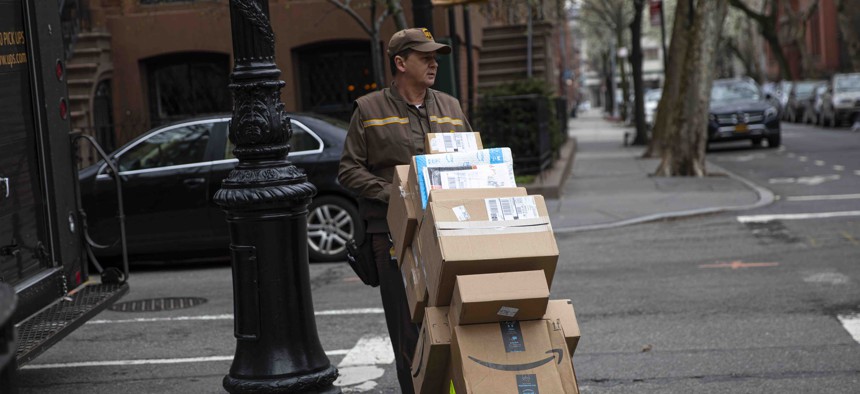NYC Experiments with 'Microhubs' to Ease Street Congestion

A delivery man for United Parcel Service, UPS, moves his hand truck loaded with packages through a residential neighborhood in Brooklyn, New York. Robert Nickelsberg/Getty Images
Delivery centers will take some trucks off the streets to reduce double and illegal parking that snarls traffic.
Trucks delivering packages from online purchases have made the traffic-choked streets of New York City even more crowded. Now the city is launching an experiment to help those trucks make fewer stops by setting up “microhubs” that let workers with cargo bikes, hand carts and other smaller devices take care of the last few blocks of the delivery.
Currently, close to 90% of deliveries in the city are moved by truck, the New York Department of Transportation explained in a recent press release.
“This overreliance on trucks exacerbates traffic congestion, contributes to public safety challenges on our roadways, pollutes our air, stresses our aging infrastructure, and negatively impacts quality of life,” the agency wrote. “Local delivery hubs offer promising potential to reduce the number of large trucks on local streets by providing safe spaces for truck operators to transfer deliveries onto more sustainable modes of transportation.”
The voluntary pilot program is scheduled to launch this summer, with the city planning to set up 20 initial sites for the delivery hubs. Transportation officials said they will use both curbside and off-street sites for the consolidated deliveries and will consider an area’s density, proximity to bike lanes and truck routes, and community input when picking the first sites.
It would be up to the delivery companies to decide how to transport packages from the new hubs to their final destinations, according to the New York City DOT. The effort is “complementary” to a separate commercial cargo bike delivery pilot program that the city launched in 2019, a spokesperson said.
New York’s new initiative could have an outsized impact, said Tiffany-Ann Taylor, the vice president for transportation at the Regional Plan Association, an advocacy group in the New York region.
“We can learn a lot from cities,” she said. “Not everybody lives in the city, but we can learn a lot from them. And street space is really prime real estate, as are sidewalks…. So really thinking about ways that are relatively simple fixes to address these challenges is a good thing.”
The pressure put on street networks and curbsides from package deliveries has grown dramatically since the beginning of the pandemic, when people started ordering more goods online instead of going out to get them at a store, she said.
City officials say more than 80% of New York residents get at least one package at home every week, while 18% receive packages on four or more days per week. To handle that volume of packages, delivery workers often double park or park in illegal spaces and that clogs up spaces where other people are trying to travel, Taylor noted.
Sometimes they even spread packages on the sidewalks for sorting and distribution. “In the moment, that’s safe, especially for drivers. We don’t want drivers doing those sorts of activities in the roadway,” Taylor said. “But it isn’t the best use of our sidewalks. They have other uses, especially for mobility.”
Taylor said delivery companies could benefit from using smaller devices for the last few blocks. They could save money by decreasing the amount of wear on their trucks and they could improve safety for their workers.
To get widespread adoption, though, the city will have to address several potential problems, she said. The first is a 2020 state law that made electric-assist bicycles wider than 36 inches illegal. That’s far narrower than industry standards, meaning delivery companies would have to buy custom-built cargo bikes to operate in New York City, Taylor said. State legislation that would increase the width limit has stalled in Albany for the last several years.
City officials also need to consider what changes might be needed at microhub locations, Taylor said. That could mean installing better lighting to improve security, adding curb cuts or minimizing points of conflict with pedestrians and cyclists using existing sidewalks and bike lanes, she said.
New York is not the first city to try cutting the hassle from the surge in deliveries. New York officials looked at a six-month pilot program in Philadelphia that allowed drivers to reserve curb space using an app. The experiment concluded in April, but New York officials suggested that they might want to use an app-based approach in the future. In 2019, Washington, D.C. ran a similar program that led to a 64% reduction in double parking, but District officials cut the program short because of problems enforcing the reserved parking zones.
Taylor said she hoped programs like those in New York City will help customers think twice about their online shopping habits, and how they affect traffic and the accessibility of their local roads and sidewalks, particularly for people who are disabled.
“Freight as a system has been designed to be invisible,” she said. “The pandemic for the first time has made people hyper aware of how goods get to them.”
“The visibility of a program like this will help in getting customers to really understand what it means when you purchase something online, and how that impacts your own neighborhood,” Taylor added. “It should make you ask yourself: Is this something that I really need in an emergency? Is this something that I can pick up while I’m running other errands? It’s understanding the consumer contribution to the challenges we face.”
Daniel C. Vock is a senior reporter for Route Fifty based in Washington, D.C.
NEXT STORY: How local governments can rise to the infrastructure complexity challenge






